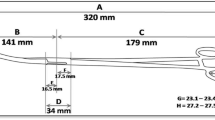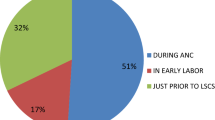Abstract
This review reports the experience of nine studies in Chinese maternity hospitals with insertions of an intrauterine device (IUD) at the time of cesarean section. In contrast to the usually high expulsion rates associated with immediate postpartum vaginal insertions, all nine studies reported low expulsion rates, thus resulting in high continuation rates with this procedure, comparable to those with interval insertions. This immediate post-cesarean section insertion procedure was also found to be safe.
These findings are of programmatic importance for postpartum family planning delivery services and may eventually lead to an understanding of the expulsion mechanism in postpartum IUD contraception. Results of these reports have been synthesized in this review. Seven of these nine reports were originally in Chinese and were translated into English for the benefit of a broad international audience. Future research directions on this insertion procedure are also discussed.
Resumé
Cette analyse porte sur neuf études faites dans des maternités chinoises sur des insertions de dispositifs intra-utérins (DIU) lors d'une césarienne. Alors que les taux d'expulsion sont généralement élevés lors d'insertions vaginales post-partum immédiates, ces neuf études ont toutes montré des taux d'expulsions faibles, comparables à ceux des insertions après intervalle. On a également constaté qu'une insertion pratiquée immédiatement après une césarienne est une méthode sûre.
Ces résultats sont très importants pour le planning familial d'une famille après une naissance et peuvent, par la suite, permettre de comprendre les mécanismes d'expulsion en cas de contraception post-partum avec stérilet. Ce document synthétise les résultats de ces études. Sept rapports ont été initialement rédigés en chinois et traduits en anglais pour des lecteurs de tous pays. La discussion porte également sur les voies d'investigation future quant à cette méthode d'insertion.
Sumario
Esta revisión relata la experiencia de nueve estudios en hospitales de maternidad chinos, con inserciones de un dispositivo intrauterino (DIU) en el momento de una operación cesárea. Contrastando con las habituales altas tasas de expulsión asociadas con inserciones vaginales inmediatas postparto, los nueve estudios informan bajas tasas de expulsión resultando así en altas tasas de continuidad con este procedimiento, comparables a aquéllas con inserciones de intervalo. Esta inserción inmediata a la operación cesárea se encontró es segura.
Estos hallazgos son de importancia programática para los servicios de planificación familiar postparto y, eventualmente, pueden conducir a la comprensión del mecanismo de expulsión en la anticoncepción postparto con DIU. Los resultados de estos informes han sido resumidos en esta revisión. Siete de estos nueve informes estaban originalmente en chino y fueron traducidos al inglés para el beneficio de una amplia audiencia internacional. También se discuten posibles direcciones de futuras investigaciones de este procedimiento de inserción.
Similar content being viewed by others
References
Liskin, L. (1982). IUDs: an appropriate contraceptive for many women.Population Reports, SeriesB4, B-101
Chen, P. C. (1982). Population and birth planning in the People's Republic of China.Population Reports Series J25, J-590–591
LinS. and ZhangS. (1983). A study of the indications and complications for cesarean section.Chin. J. Obstet. Gynecol,18, 108–111
ChengJ. M. and GuS. H. (1983). The rising cesarean section rate — Its effect on the mother and neonate.Chin. J. Obstet. Gynecol.,18, 21–24
ChiI-c, ZhouSu-wen, BaloghS. and NgK. (1984). Postcesarean section insertion of intrauterine devices.Am. J. Publ. Health,74, 1281–1282
LiFang-nan. (1981). A one-year observation of IUD insertion at cesarean section in 80 cases.Chongqing Med. J.,6, 1–2
LiHua-yuan. (1983). IUD insertion at cesarean section — 180 cases.Sichuan Med. J.,4, 285
LiuBao-hua, ZhangLi-ya, ZhangPin-ru and ShengZhu-cun. (1983). Clinical report of intrauterine contraceptive device insertion with suture fixation at cesarean section.Reprod. Contracept.,3, 37–41
YangDa-zheng and LuRao-hua. (1984). Preliminary report of 144 cases of IUD insertion at cesarean section.Wuhan Med. J.,8, 22–23
YuGulan, (1985). Preliminary observation on the use of IUDs at the end of cesarean section (A report of 735 cases).Chin. J. Obstet. Gynecol.,20, 49–50
ZhangFi-rong, ZhuShun-xan, PanLun-zhen and CaoShi-Zhen, (1984). Observation on 300 cases of IUD insertion at cesearean section.Chin. J. Obstet. Gynecol.,19, (suppl.), 100–102
ZhouSu-wenet al., (1985). Two years' clincial experience with puerperal insertion of IUDs.Chin. J. Obstet. Gynecol.,20, 46–48
Zhuang, Lui-qi, (1985). Observations of the clinical efficacies and side effects of the four different timings of IUD insertion. Presented at theInternational Symposium of Fertility Regulation Method, organized by the State Birth Planning Commission, People's Republic of China, November 5–8, Beijing, China
LaufeL. E., WheelerR. G. and FrielP. G. (1979). Modification of intrauterine devices for postpartum insertion.Lancet,1, 853
PotterR. G. (1969). Use-effectiveness of intrauterine contraception as a problem in competing risks. In:Family Planning in Taiwan, R.Freedman and J.Takeshita (eds.), Princeton University Press, Princeton, pp. 458–484
Suddireccion General Medica, Jefatura de Servicios de Planificacion Familiar, Instituto Mexicano del Seguro Social. Informe Estadistico 1983. In:Selected Research Briefs, Network6, (2), 8, Family Health International, 1985
ColeL. P., EdelmanD. A., PottsD. M.et al. (1984). Postpartum insertion of modified intrauterine devices.J. Reprod. Med.,29, 677–682
ZatuchniG. I. (1970). Overview of program: two-year experience. In:Postpartum Family Planning, G. I.Zatuchni (ed.), McGraw-Hill, New York, pp. 30–88
World Health Organization, Special Programme of Research Development and Research Training in Human Reproduction, Task Force on Intrauterine Devices for Fertility Regulation. (1980). Comparative multicenter trial of three IUDs inserted immediately following delivery of the placenta.Contraception,22, 9–15
YuMai-ying. (1979). Two-year observation of 97 cases of immediate postpartum insertion of stainless steel ring.Shanghai Med. J.,2, 44
Lavin, P. Personal communication.
HutchingsJ. E., BensonP. J., PerkinG. E. and SoderstromR. M. (1985). The IUD after 20 years: a review.Fam. Plann. Perspectives,17, 244–255
TietzeC. and LewitS. (1970). Evaluation of intrauterine device: ninth progress report of the Cooperative Statistical Program.Stud. Fam. Plann.,55, 1–40
Author information
Authors and Affiliations
Rights and permissions
About this article
Cite this article
Chi, IC., Ji, G., Siemens, A.J. et al. IUD insertion at cesarean section — the Chinese experience. Adv Contracept 2, 145–153 (1986). https://doi.org/10.1007/BF01849224
Received:
Accepted:
Issue Date:
DOI: https://doi.org/10.1007/BF01849224




